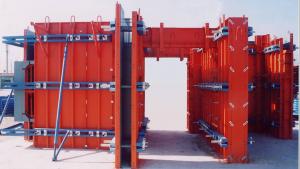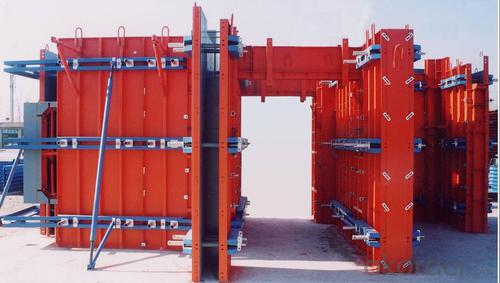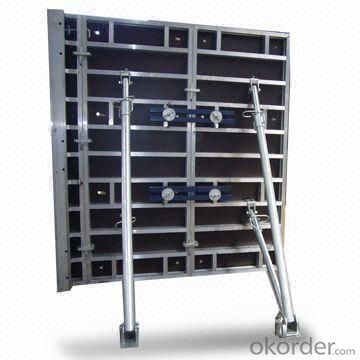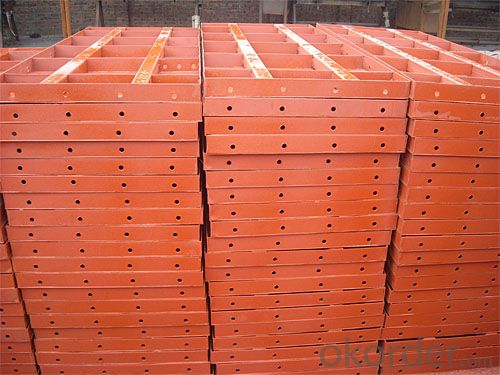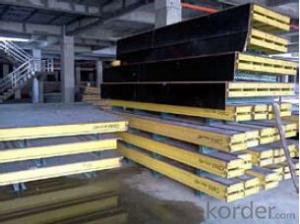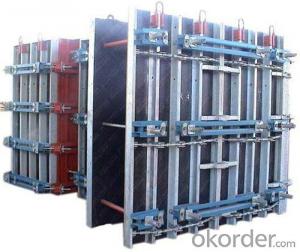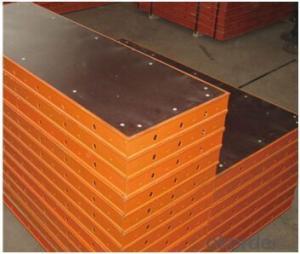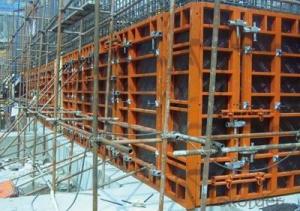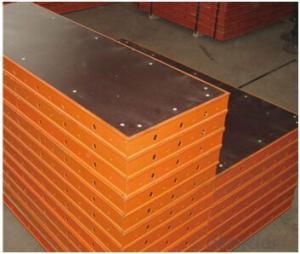Light Steel Frame Formwork from CNBM China
- Loading Port:
- Shanghai
- Payment Terms:
- TT OR LC
- Min Order Qty:
- 100 m.t.
- Supply Capability:
- 10000 m.t./month
OKorder Service Pledge
OKorder Financial Service
You Might Also Like
Formwork system
1. CNBM Universal Panel Formwork System consists of steel frame, plywood panel, push-pull prop, scaffold bracket, alignment coupler, compensation waler, tie rod, lifting hook, etc.
2. Plywood panels could be Wisa -form or homemade plywood with high quality. The steel frames therein are made of special cold roll-forming steel, no waler, with the weight of 64kg/m2 so as to easy to carry.
3. The connection between panels adopts alignment coupler rather than those of bolts or ‘‘U’’ clips which are low efficient and complicated so that it greatly improves the working efficiency.
4. Compensation water strengthens its integrate rigidity at panel connection location.
5. High turnover, easy operation, reasonable load, convenient storage and transportation, low aggregate costs.
6. CNBM Universal Panel Formwork System completely makes the formwork implementation, mechanization, and standardization come true, in other words, an ordinary tool, for example a hammer, is nough to finish the erection work efficiently.
Slab Forms Products
1. Quick Info
a. Model: Slab Formwork (pure steel, electrophoretic coated)
b. Application: used together with plywood for concrete form.
d. Load Capacity: 3500kg per s.q.m.(whole system)
e. Installation: A group of 4 workers can erect 300s.q.m in 8 hours.
Type | Length*Width(mm) | ||
L600 | 600*600 | 600*1200 | 600*3000 |
L950 | 950*600 | 950*1200 | 950*3000 |
L1200 | 1200*600 | 1200*1200 | 1200*3000 |
L1500 | 1500*600 | 1500*1200 | 1500*3000 |
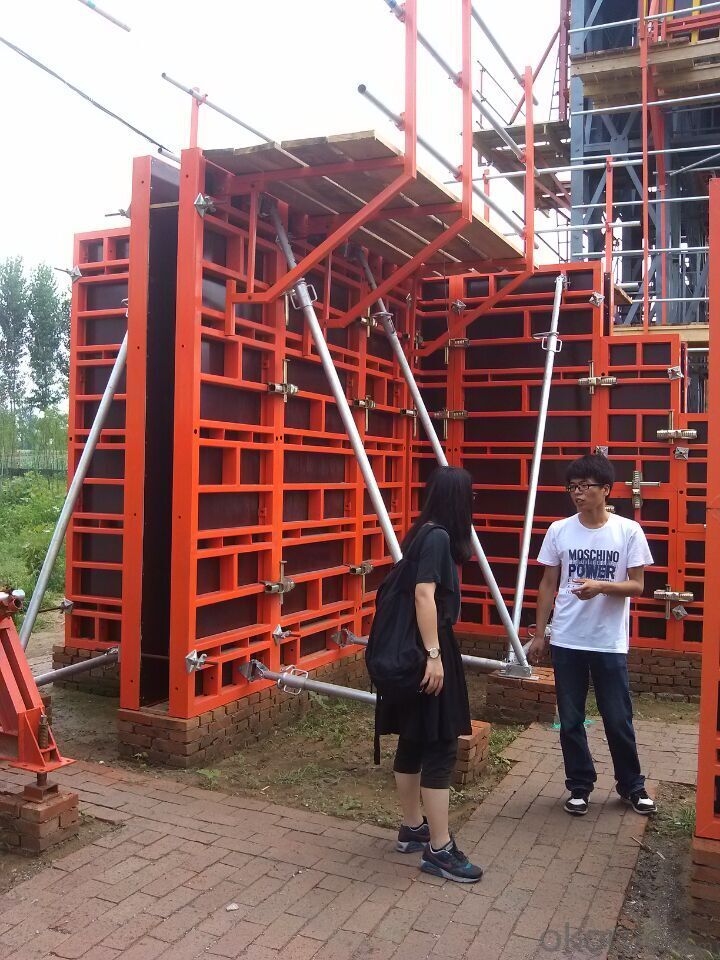

- Q: What are the different locking mechanisms used in steel formwork?
- To ensure stability and integrity in concrete construction projects, various locking mechanisms are employed in steel formwork. These mechanisms are designed to securely fasten the formwork panels together, preventing any shifting or movement that could compromise the accuracy and quality of the final concrete structure. One widely used locking mechanism is the wedge clamp system. This system utilizes steel wedges, which are inserted between the formwork panels and tightened with a hammer or mallet. The wedges establish a robust connection between the panels, firmly anchoring them in place. Another popular locking mechanism is the pin and wedge system. This system involves the insertion of steel pins through holes in the formwork panels. Subsequently, steel wedges are driven into these holes, securing the pins firmly. This creates a stable and secure connection between the panels. Some steel formwork systems also employ a hook and loop mechanism. This entails the attachment of metal hooks to one panel and metal loops to the neighboring panel. The hooks and loops interlock, providing a strong connection between the panels. This mechanism is often favored for its convenience and efficiency, making it a popular choice for specific construction projects. Moreover, certain steel formwork systems combine different locking mechanisms. For instance, a system may incorporate both wedge clamps and pin and wedge systems to enhance stability and strength. Ultimately, the various locking mechanisms employed in steel formwork serve the purpose of ensuring the secure connection of formwork panels throughout the concrete pouring process. Each mechanism offers its own advantages and may be more suitable for specific project requirements.
- Q: How is steel formwork different from other types of formwork?
- Steel formwork differs from other types of formwork primarily because it is constructed from steel, which provides several distinct advantages. Firstly, steel formwork exhibits exceptional durability and can endure heavy loads and repeated use without warping or damage. This makes it well-suited for utilization in extensive construction ventures where formwork must be employed multiple times. Furthermore, steel formwork is renowned for its remarkable strength and stability. It can support concrete walls and slabs without necessitating supplementary support structures, reducing construction time and expenses. Its inflexibility also guarantees that the formwork retains its shape and prevents concrete from leaking or shifting during pouring and curing. Another notable benefit of steel formwork is its adaptability and versatility. It can be easily tailored to meet diverse project requirements, enabling the construction of intricate shapes and designs. This flexibility renders steel formwork suitable for a wide array of applications, including tall buildings, bridges, tunnels, and even curved structures. Moreover, steel formwork provides excellent surface finish quality. Its smooth and uniform surface diminishes the need for additional finishing work, conserving time and resources. It also imparts a uniform appearance to the completed concrete structure. In terms of cost-effectiveness, steel formwork may entail a higher initial investment compared to other formwork types, such as wood or aluminum. However, its durability and reusability compensate for the higher upfront expenses in the long run. Additionally, the efficiency and rapidity of construction achieved with steel formwork can result in substantial time and labor savings, making it a cost-effective choice for large-scale projects. Overall, steel formwork distinguishes itself through its durability, strength, adaptability, surface finish quality, and cost-effectiveness. These characteristics render it a popular selection in the construction industry for projects that require a sturdy and dependable formwork system.
- Q: How does steel formwork handle formwork reuse and recycling?
- Steel formwork is highly durable and can withstand multiple uses without compromising its structural integrity. This allows for effective formwork reuse, reducing the overall cost and environmental impact of construction projects. Additionally, steel formwork is recyclable, making it a sustainable choice as it can be melted down and repurposed for future construction needs.
- Q: Can steel formwork be used in areas with high chemical exposure?
- Steel formwork can be used in areas with high chemical exposure, but it may not be the most ideal choice. Steel is generally a durable and strong material, but it can be susceptible to corrosion when exposed to certain chemicals. If the chemicals present in the area are known to corrode steel, it is recommended to consider alternative formwork materials such as plastic or aluminum, which may be more resistant to chemical exposure. Additionally, protective coatings or treatments can be applied to steel formwork to enhance its resistance to chemicals. However, it is important to evaluate the specific chemicals and their concentration in the area to determine the most suitable formwork material for the project.
- Q: Can steel formwork be used for school construction projects?
- Indeed, school construction projects can make use of steel formwork. Steel formwork, being a resilient and versatile construction material, is capable of withstanding the immense loads and pressures encountered within school buildings. It provides a robust and steadfast framework for pouring concrete, thus ensuring the structural integrity of the construction. Furthermore, steel formwork is designed to be reusable, thereby offering a cost-effective option for school construction projects. Its adaptability allows for the creation of various shapes and sizes, catering to the distinct architectural designs typically found in school buildings. Moreover, steel formwork facilitates faster construction times when compared to traditional timber formwork, enabling the swift completion of school projects. In summary, steel formwork represents a fitting and dependable choice for school construction projects.
- Q: How much time does it take to install steel formwork?
- The time it takes to install steel formwork can vary depending on various factors such as the size and complexity of the project, the expertise of the workers, and the availability of equipment. However, on average, it typically takes several hours to a few days to complete the installation process.
- Q: Can steel formwork be used for both flat and sloped surfaces?
- Yes, steel formwork can be used for both flat and sloped surfaces. Steel formwork is a versatile and durable option for construction projects and can be easily adapted to form structures with various slopes. The flexibility of steel allows it to be bent or shaped to the desired angle, making it suitable for creating formwork for sloped surfaces. Additionally, steel formwork provides excellent support and stability, ensuring that the concrete is poured accurately and evenly on both flat and sloped surfaces. Its strength and rigidity make it a reliable choice for constructing formwork systems that can withstand the pressures exerted by the concrete during the casting process, regardless of the surface slope.
- Q: What are the different types of bracing used with steel formwork?
- The stability and strength of the structure being formed are ensured through the utilization of various types of bracing with steel formwork. Each type serves a specific purpose in achieving this goal. 1. Diagonal Bracing: To prevent lateral movement of the formwork and provide stability, diagonal braces are employed. These braces are typically positioned at an angle between two corners of the formwork, creating an "X" shape. They assist in evenly distributing loads and resisting the forces acting on the structure. 2. Vertical Bracing: In order to support the formwork vertically and prevent sagging or bulging, vertical braces are utilized. These braces are usually installed at regular intervals along the height of the formwork, offering additional support and rigidity to the structure. 3. Horizontal Bracing: Horizontal braces are implemented to counteract the horizontal forces acting on the formwork. They are placed horizontally, typically at the top and bottom of the formwork or at specific intervals along its length. This provides stability and prevents deformation caused by external loads. 4. Tension Rod Bracing: Tension rods are employed to distribute loads and reinforce the formwork. Depending on the specific requirements of the structure, these rods are typically installed diagonally or horizontally. Tension rod bracing is especially effective in resisting excessive deflection and preventing the formwork from collapsing under heavy loads. 5. External Bracing: When additional support is necessary, especially in the face of high wind loads or other external forces, external bracing is used. These braces are usually positioned on the outer side of the formwork and are designed to offer extra stability and prevent deformations caused by external factors. 6. Tie Rods: To hold the formwork together and apply uniform pressure on the structure, tie rods are employed. These rods are commonly installed horizontally or vertically and are tightened with nuts to secure the formwork in place. Tie rods also aid in evenly distributing loads across the formwork, preventing bulging or deformation. In summary, the different types of bracing utilized with steel formwork play a vital role in ensuring the stability, strength, and integrity of the structure being formed. They work collectively to resist external forces, distribute loads evenly, and prevent deformations or failures during the construction process.
- Q: How does steel formwork handle different concrete setting time requirements?
- Steel formwork is highly versatile and can easily accommodate different concrete setting time requirements. It provides a rigid and sturdy framework that supports the concrete during the setting process. The steel formwork allows for precise shaping and molding of the concrete, enabling it to take various forms and designs. Additionally, steel formwork offers adjustable features, such as adjustable joints and connectors, which allow for quick assembly and disassembly, making it efficient in meeting different concrete setting time requirements. Overall, steel formwork provides a reliable and adaptable solution for handling different concrete setting time requirements.
- Q: How does steel formwork affect the overall fire resistance of a building?
- Steel formwork does not directly affect the overall fire resistance of a building as it is primarily used for temporary structures during construction. The fire resistance of a building is determined by the materials used in its permanent structure, such as the type of steel used in the beams, columns, and fireproof insulation.
Send your message to us
Light Steel Frame Formwork from CNBM China
- Loading Port:
- Shanghai
- Payment Terms:
- TT OR LC
- Min Order Qty:
- 100 m.t.
- Supply Capability:
- 10000 m.t./month
OKorder Service Pledge
OKorder Financial Service
Similar products
Hot products
Hot Searches
